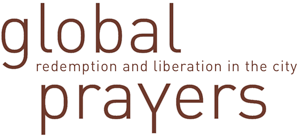There is a sign on the edge of Berlin’s Alexandrinenstrasse marking precisely the exact geographical center of the city. However, this center is not located in the city district of “Mitte” (center) itself, nor does it convey the impression of being a particularly central spot. Alexandrinenstrasse lies within the relatively peaceful and green periphery of the district of Kreuzberg. The Jewish Museum in the Lindenstrasse is but a stone’s throw away, and directly opposite the sign stands the church of St. Agnes, which despite its ostensibly unassuming appearance, is a very special monument.
Its architect, Werner Düttmann, one of the leading representatives of postwar German modernism, also designed the old Academy of the Arts in Berlin’s Tiergarten. St. Agnes was built in the Cubist style in 1967, and had a crucifix not been mounted onto the front face of the weather-beaten concrete campanile, one would be hard-pressed to believe that this highly functional building was once a house of God. Faced with ever dwindling congregations, the Catholic authorities leased St. Agnes in 2004 to the “City Kirche Berlin International,” an Evangelical Free Church, which filmed their Gospel-based services for television and broadcast them via satellite to Asia. Within a few years, however, the “City Kirche” had also run its course. The church was then sold to a private real-estate company, which, in turn, leased it to the gallery owner Johann König. He renovated and converted the building to suit his own purposes; and now the profaned church space is destined to house an exhibition hall.
This development has a certain intrinsic logic to it. The fact that galleries and art institutions in Berlin, two-thirds of whose population profess to no religious affiliations, exercise a greater potential attraction than churches or perhaps have even become the modern houses of worship, can be gleaned from the numbers of visitors passing through their doors. The sociologist Peter L. Berger even once described Berlin as the “capital city of atheism.” For it would appear that religion in this city enjoys at best only temporary status. In the meantime the “City Kirche” has relocated to the district of Westend and on its website
it features a quotation from the New Testament which could not describe the situation more appositely: “For here we have no lasting city, but we seek the city that is to come.” (Hebrews 13: 14).
Prussian Berlin, which only grew into a genuine metropolis by virtue of the industrialization of the nineteenth century, was never a religious city. In the nineteenth century, Marxists saw here the revolutionary future of the proletariat, and in years to come the Socialist eastern half of the city would even institutionalize atheism. In Berlin religions have always had to contend with opposition from the city. A striking example of this is the role played by East Berlin churches in the reunification process. They drew their influence from the dissident underground, which also afforded them their political credibility. East Berlin never experienced any notable influx of people of other faiths, for even the migrants from their Socialist “brother” countries such as Vietnam were atheist.
Consequently, the city’s visible migrant-driven diversity of religions is based in West Berlin, where Islam represents the most high-profile religious movement. Initially comprising highly fragmented individual groupings, large-scale organizations such as Milli Görüş have become established among the Turkish population since the 1970s, which endeavored to integrate Muslims into centralized faith communities. The fact many mosques were initially set up in basements, offices, or even flats and, thus, remained hidden from the public eye, merely reflected the expectations of many immigrants of subsequently returning to their native countries.
However, there was a growing demand for less provisional sacred premises, which were now to have a representative function. Opened in 2005 at the Neuköllner Columbia-Damm, the Şehitlik Mosque, boasting a thirty-seven meter-high minaret, is the most conspicuous example of this. Its construction was funded by the “Turkish-Islamic Union for Religious Affairs” (DITIB), an organization which falls under the control of the Turkish state. However, the visibility of the Islamic house of worship came at a price, as it immediately provoked a xenophobic response: although there is no suspicion that the Şehitlik mosque promotes a radical form of Islam, it has been the subject of several arson attacks—perpetrated not by atheists, but by extreme right-wing groups.
The religious diversity of the city has also been instrumentalized for strategic political purposes in other regards: when in 2009 the “Pro Reli” initiative narrowly failed to secure the requisite majority in a referendum over whether religious instruction should be made compulsory on the city’s school curriculum, the then-mayor, Walter Momper, expressed his delight by stating that the subject of religion had been impeding the integration of migrant children. Yet whether the residents had voted against the initiative out of respect for other religions or out of rejection of their own—is difficult to ascertain in Berlin, the “global capital of atheism.”

- Jesus Freaks Berlin at the Kindl Brauerei. Photo: Kallenberger / Nold

